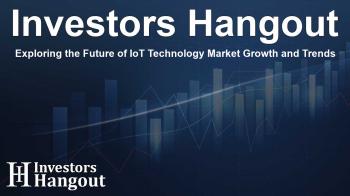Exploring the Future of IoT Technology Market Growth and Trends

Overview of the IoT Technology Market
The IoT technology market is on a trajectory to reach approximately USD 1,148.62 billion by 2030. This marks a notable increase from USD 959.30 billion in recent years. With a compound annual growth rate (CAGR) of 3.7%, the market is witnessing significant transformations driven by the increasing adoption of connected devices in various industries.
Drivers of IoT Market Growth
The growth of the IoT technology market is being propelled by several factors. Key among them is the surge in connected devices that facilitate real-time monitoring and automation across different sectors. Technologies such as 5G, cloud computing, and artificial intelligence (AI) play a critical role in enhancing the capabilities and applications of IoT solutions. Furthermore, the demand for smart homes, wearables, and industrial IoT solutions contributes significantly to these large-scale deployments.
Advancements in Technology
The rise of advanced technologies is a cornerstone of the IoT revolution. Improved 5G connectivity allows for faster and more reliable data transfer, which is essential for the efficiency of IoT devices. Additionally, cloud computing provides the infrastructure needed to support vast amounts of data generated by these devices, while AI helps in analyzing this data for actionable insights.
Government Initiatives
Government policies play an instrumental role in the adoption of IoT technologies. Initiatives aimed at boosting digital infrastructure and the development of smart cities are accelerating the penetration of IoT worldwide. By investing in public resources, governments are creating environments conducive to innovation and growth.
Market Segmentation Insights
IoT technology caters to different market segments, each with unique drivers and growth patterns. A prominent segment within the market is the node component category, with processors being the leading component type. These processors include microcontrollers and digital signal processors that are crucial for powered IoT devices needing real-time data monitoring.
Wearable Devices Surge
Another significant growth area is the wearables market, which incorporates products like smart watches and activity monitors. These devices leverage IoT technology to deliver functionalities ranging from monitoring vital signs to providing communication capabilities similar to smartphones. As the consumer electronics segment expands, wearables are expected to exhibit the highest CAGR among IoT technology components.
Regional Insights into IoT Development
The Asia Pacific region is becoming a hotspot for IoT technology growth, anticipated to see the highest rate of expansion in the near future. Factors contributing to this growth include rapid digital transformation and substantial governmental backing in nations such as China and India. Investments in 5G infrastructure and smart city projects serve as a robust base for broader IoT integration.
Diverse Market Opportunities
The region's combination of developed and emerging economies offers diverse opportunities for IoT deployments. There is a growing demand for connected healthcare solutions and smart devices that enhance everyday living, which accelerates the adoption of IoT technology in both consumer and industrial sectors.
Key Players Shaping the IoT Landscape
Several key players are driving innovation and competition in the IoT technology market. Companies like Intel, Qualcomm, and Cisco are at the forefront, developing cutting-edge solutions that push the boundaries of what IoT can achieve. By focusing on factors such as performance, energy efficiency, and cost, these organizations are shaping the future of connected technology.
Future Outlook
As global trends continue to evolve, the IoT technology market will likely expand its reach, creating new avenues for growth. Collaborations between technology firms and local players will foster innovation tailored to specific regional needs, ensuring that IoT applications are accessible and beneficial across different markets.
Frequently Asked Questions
What is the projected growth of the IoT technology market?
The IoT technology market is projected to reach USD 1,148.62 billion by 2030, growing at a CAGR of 3.7%.
What are the main drivers of IoT market growth?
The primary drivers include advancements in technology such as 5G and AI, rising adoption of smart devices, and supportive government initiatives.
Which segment is expected to lead the IoT market?
Processors are anticipated to hold the largest market share within the node component segment due to their critical role in supporting IoT functionalities.
Where is the highest growth anticipated in the IoT market?
The Asia Pacific region is expected to witness the highest CAGR over the forecast period, driven by substantial investments and digital transformation initiatives.
Who are the key players in the IoT technology space?
Key players include Intel, Qualcomm, Cisco, IBM, and Amazon Web Services, among others, who are focused on innovation in IoT solutions.
About The Author
Contact Evelyn Baker privately here. Or send an email with ATTN: Evelyn Baker as the subject to contact@investorshangout.com.
About Investors Hangout
Investors Hangout is a leading online stock forum for financial discussion and learning, offering a wide range of free tools and resources. It draws in traders of all levels, who exchange market knowledge, investigate trading tactics, and keep an eye on industry developments in real time. Featuring financial articles, stock message boards, quotes, charts, company profiles, and live news updates. Through cooperative learning and a wealth of informational resources, it helps users from novices creating their first portfolios to experts honing their techniques. Join Investors Hangout today: https://investorshangout.com/
The content of this article is based on factual, publicly available information and does not represent legal, financial, or investment advice. Investors Hangout does not offer financial advice, and the author is not a licensed financial advisor. Consult a qualified advisor before making any financial or investment decisions based on this article. This article should not be considered advice to purchase, sell, or hold any securities or other investments. If any of the material provided here is inaccurate, please contact us for corrections.

